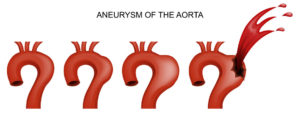 If you think an abdominal aortic aneurysm doesn’t sound like good news, you’re correct. Though this condition isn’t widely recognized like stroke or heart attack, it is nonetheless essential that you can identify the symptoms and save yourself from severe health complications.
If you think an abdominal aortic aneurysm doesn’t sound like good news, you’re correct. Though this condition isn’t widely recognized like stroke or heart attack, it is nonetheless essential that you can identify the symptoms and save yourself from severe health complications.
What Is an Abdominal Aortic Aneurysm?
Overall, an abdominal aortic aneurysm is an unusual widening of the abdominal aorta that can cause other health complications. The aorta is a major blood vessel that supplies blood throughout your body. It is actually about as thick as a garden hose and runs from your heart through the center of your chest and abdomen. The abdominal aorta is responsible for supplying blood to your legs. When the wall of the abdominal aorta weakens, a balloon-like dilation develops. This is known as an aneurysm.
What Signs Indicate An Abdominal Aortic Aneurysm?
Unfortunately, an abdominal aortic aneurysm tends to grow slowly and without symptoms, so it is difficult to detect until some damage has already been done. While some aneurysms will never rupture, others will continue to expand over time until they do burst. If you have started to notice any of the following symptoms, it could be due to an abdominal aortic aneurysm:
- Pulsating sensation near the navel
- Back pain
- Constant deep pain in your abdomen
If you use tobacco, have exiting atherosclerosis, or know of family members with AAA, you are at higher risk of developing an abdominal aortic aneurysm yourself. The people at highest risk are older white males.
How Is An Abdominal Aortic Aneurysm Treated?
Since the complications of abdominal aortic aneurysm include intense and persistent abdominal and back pain, sweating, nausea, and low blood pressure, treatment is essential. The goal of treatment is to prevent your aneurysm from rupturing through medical monitoring and/or surgery.
If you are concerned about your own cardiovascular health and potential existence of an aneurysm, call (941) 747-8789 to make an appointment at Cardiovascular Solutions Institute in Bradenton, Florida.

 Patient Login
Patient Login